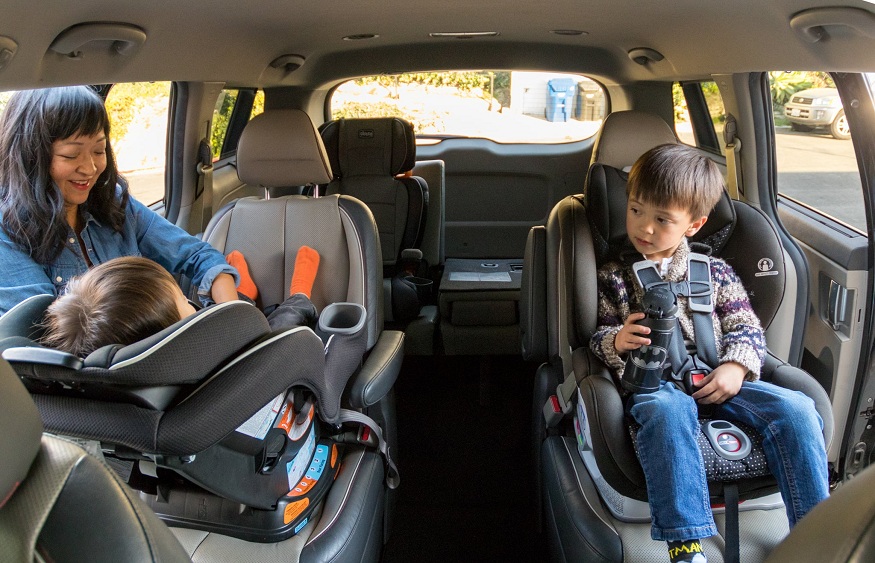Before proceeding with the installation of the car seat, be sure to read the manufacturer’s instructions carefully, because most car seats have specific features that may be invisible at first glance. This can also reassure you if your car seat moves: perhaps this is normal, since the seat belt retractor is designed to lock in the event of an impact.
Good to know: for car seats with a strut, it is important to read the instructions for your vehicle to find out if you have trunks because the strut must not rest on them.
For car seats installed in the front of your vehicle, be sure to deactivate the airbag when it comes to rear-facing seats. For forward-facing seats, the airbag must be activated and the car seat must be moved back as far as possible to prevent the airbag from injuring your child in the event of a collision.
Good to know: installing a forward-facing car seat in the front of a vehicle is strongly discouraged and should be avoided to ensure your child’s safety. For more information, we invite you to consult the excellent article made by Sécurange, which completes its explanations with very clear diagrams.
When to turn the car seat forward facing?
The rear-facing position is safer for young children because, in the event of a collision, the body is held against the car seat instead of being thrown forward, which allows the head, neck and the spine to be better protected. However, the duration of the rear-facing position depends on the approval of the car seat used.
Good to know: traveling rearward facing is recommended for as long as possible. This is the best way to protect the neck and the cervical of a child.
Up to what age is a car seat compulsory for your child?
The first thing to know is that a child under the age of 10 must legally sit in the back of your vehicle ; unless it’s a baby in a rear-facing car seat or there’s simply no back seat. Then a car seat or a booster seat with backrest is mandatory until your child reaches 36 kg or 150 cm, which usually happens around the age of 10.
Good to know: the backrest prevents the booster seat from sliding under your child in the event of an impact (which would make it useless in a collision), while better protecting his back.
To find out more about the French regulations concerning the use of car seats, we advise you to read this article from the public service and this article from the government site specializing in road safety.
When should you change your child’s car seat?
Good to know: if a car seat has suffered an impact, it may no longer be as efficient in terms of safety as when it was purchased. We therefore advise you not to buy this second-hand product and to contact the brand in case of doubt if you have to pass a car seat on to another child. Often, the manufacturer will be able to offer you a diagnosis that will allow you to have a functional car seat. In any case, we advise you to look at the crash test results of each car seat to be sure of their effectiveness in terms of safety and comfort for your child.
Which crash tests to rely on?
Crash tests are used to evaluate the reaction of car seats in the event of a violent collision so that you know which ones best protect your child. We recommend that you rely on independent crash test institutes which are not paid by brands and are fully concerned about the safety of children. You can find the main ones in our guide to car seat labels.
How to clean the car seat?
Unfortunately, there is no magic recipe for cleaning all car seats. The best, once again, is to refer to the manufacturer’s documentation. Nevertheless, we advise you to use car seat covers which will make your daily life easier and help your child to be less hot in summer. In principle, each car seat model has a specific cover!
How to install the car seat?
Once again: it all depends on your car seat and the fixing requirements it includes: isofix, strut, top tether, tether straps, anti-rebound bar.
All of these elements are used to correctly install the car seat in your car. We invite you to check the type of installation supported by your vehicle beforehand.
Once your purchase has been made, our personal shopper will be able to help you fix your car seat free of charge if you are in the Toulouse area! In any case, we remain at your disposal to advise you before your purchase and help you make the best choice for your baby and for you.
Do you need a hull or not?
No, it depends on your lifestyle. The shell can be used in the car as a car seat (recommended from birth) and can be clipped onto pushchairs for more everyday practicality (depending on the shell and pushchair models). It is therefore not essential, but very useful depending on your situation.
Can I use a carrycot in the car?
The use of a carrycot in the car is not recommended because it is much less safe in terms of safety than a shell or a car seat adapted to the age of the child.
However, there are carrycots approved for installation in the car (attachment straps + harness to hold the child) but we do not recommend their use.
The isize standard (ERE 129) aims to complete the ECER 44 standard. It has been mandatory since 2018, meaning manufacturers must comply and fewer and fewer non-i-size seats will be released over the years.

